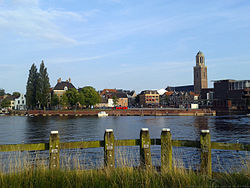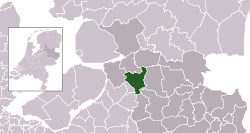Zwolle
| Zwolle | |||
|---|---|---|---|
| City and Municipality | |||

Zwolle city centre
|
|||
|
|||
 Location in Overijssel |
|||
| Coordinates: 52°31′N 6°6′E / 52.517°N 6.100°ECoordinates: 52°31′N 6°6′E / 52.517°N 6.100°E | |||
| Country | Netherlands | ||
| Province | Overijssel | ||
| Government | |||
| • Body | Municipal council | ||
| • Mayor | Henk Jan Meijer (VVD) | ||
| Area | |||
| • Municipality | 119.36 km2 (46.09 sq mi) | ||
| • Land | 111.38 km2 (43.00 sq mi) | ||
| • Water | 7.98 km2 (3.08 sq mi) | ||
| Elevation | 4 m (13 ft) | ||
| Population (Municipality, May 2014; Urban and Metro, May 2014) | |||
| • Municipality | 123,507 | ||
| • Density | 1,109/km2 (2,870/sq mi) | ||
| • Urban | 123,507 | ||
| • Metro | 181,440 | ||
| Demonym(s) | Zwollenaar | ||
| Time zone | CET (UTC+1) | ||
| • Summer (DST) | CEST (UTC+2) | ||
| Postcode | 8000–8049 | ||
| Area code | 038 | ||
| Website | www |
||
Zwolle (Dutch: [ˈzʋɔlə]) is a municipality and the capital city of the province of Overijssel, Netherlands. It has a population around 125,000.
Archaeological findings indicate that the area surrounding Zwolle has been inhabited for a long time. A woodhenge that was found in the Zwolle-Zuid suburb in 1993 was dated to the Bronze Age period. During the Roman era, the area was inhabited by Salian Franks.
The modern city was founded around 800 A.D. by Frisian merchants and troops of Charlemagne. The name Zwolle is derived from the word Suolle, which means "hill" (cf. the English cognate verb "to swell"). This refers to an incline in the landscape between the four rivers surrounding the city, IJssel, Vecht, Aa and Zwarte Water. The hill was the only piece of land that would remain dry during the frequent floodings of the rivers. Zwolle was established on that incline.
A document mentions the existence of a parish church dedicated to St Michael. That church, the Grote or Sint Michaëlskerk (big or Saint Michael Church), was renovated in the first half of the 15th century and exists to this day. The church contains a richly carved pulpit, the work of Adam Straes van Weilborch (about 1620), some good carving and an exquisite organ (1721).
...
Wikipedia


